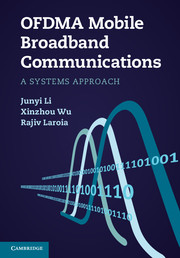Book contents
- Frontmatter
- Dedication
- Contents
- Foreword
- Preface
- List of Notation
- List of Abbreviations
- 1 Introduction
- 2 Elements of OFDMA
- 3 System design principles
- 4 Mitigation and exploitation of multipath fading
- 5 Intra-cell user multiplexing
- 6 Inter-cell interference management
- 7 Use of multiple antennas
- 8 Scheduling
- 9 Handoff in IP-based network architecture
- 10 Beyond conventional cellular frameworks
- A Overview of system operations
- B OFDM point-to-point communications
- C Brief review of channel capacity
- References
- Index
Preface
Published online by Cambridge University Press: 05 July 2013
- Frontmatter
- Dedication
- Contents
- Foreword
- Preface
- List of Notation
- List of Abbreviations
- 1 Introduction
- 2 Elements of OFDMA
- 3 System design principles
- 4 Mitigation and exploitation of multipath fading
- 5 Intra-cell user multiplexing
- 6 Inter-cell interference management
- 7 Use of multiple antennas
- 8 Scheduling
- 9 Handoff in IP-based network architecture
- 10 Beyond conventional cellular frameworks
- A Overview of system operations
- B OFDM point-to-point communications
- C Brief review of channel capacity
- References
- Index
Summary
Why we wrote this book
Back in the late 1990s, when CDMA was widely considered the dominant technology for cellular 3G, two of the authors and a few colleagues in Bell Laboratories designed an alternative technology called Flash-OFDM with two basic yet fundamental ideas: OFDMA-based airlink and all IP-based network architecture. In early 2000, we founded a startup company, Flarion Technologies, to prove Flash-OFDM in the market by building terminals and base stations, and testing and deploying the networks in a wide variety of locations, configurations, and frequency bands. As arguably the first commercially deployed OFDMA/IP-based cellular system, Flash-OFDM helped make those two ideas the key enabling features in 4G mobile broadband LTE.
From the remarkable journey of designing, developing, and deploying Flash-OFDM, we have learned, and in some cases “unlearned,” a few important lessons:
• While early cellular wireless communications design focuses predominantly on the physical layer, mobile broadband requires more system-level thinking across different protocol layers than just the physical layer. For example, OFDMA, in comparison with CDMA, more readily facilitates a simplified IP-based network architecture design, where air interface specific technology functions and processing are collapsed into a base station and IP layer protocols are used for handoff.
• Conventional wisdom developed in early cellular wireless communications needs to be reexamined from first principles. For example, the wireless channel is conventionally modeled with additive noise and multiplicative channel response; we found that selfnoise should also be included when multiplexing users with large signal dynamic range in OFDMA. As another example, universal frequency reuse is conventionally considered the most spectrally efficient; we found that for data, fractional frequency reuse improves both cell edge and cell average performance.
- Type
- Chapter
- Information
- OFDMA Mobile Broadband CommunicationsA Systems Approach, pp. xiv - xviPublisher: Cambridge University PressPrint publication year: 2013



